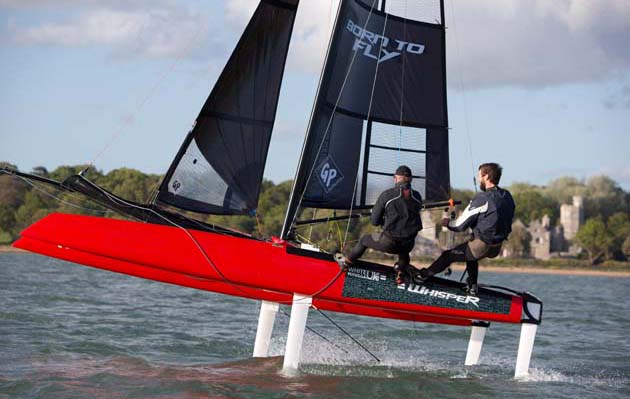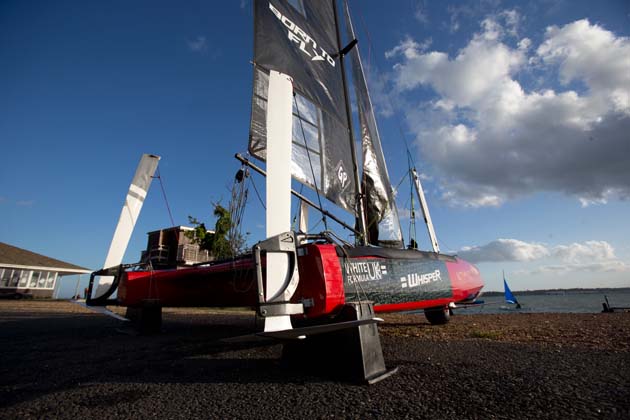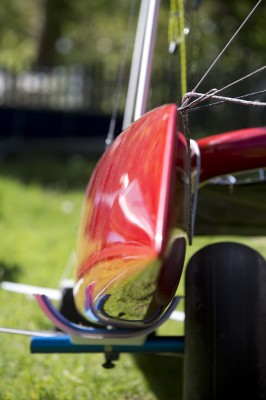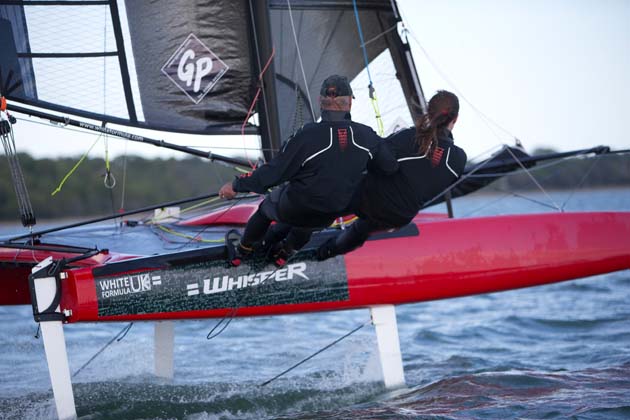“If you can sail, you can foil this boat,” says the designer of the new Formula Whisper foiling catamaran. Matthew Sheahan tests out the claim
As I stepped off the Formula Whisper, our cameraman and photographer Richard Langdon was full of praise for my first attempt at flying.
“How polite,” I thought. I had been frustrated with my first attempts – it had looked so easy in the hands of her designer. But Richard was insistent: he was surprised at how readily I had been able to foil and how long I had been flying.
It wasn’t until we went through the raw video footage that I could see what he meant. Until then I hadn’t realised how much of the time we were doing exactly what her designer had claimed was possible – foiling from the off.
In just 20 minutes my perspective had changed. This was clearly not just an interesting new design, but one that could turn out to be the turning point for performance sailing. Unless you’ve mastered sailing an International Moth recently, the chances are that you have yet to try foiling. But this new production cat could change all that and bring foiling for the club sailor a step closer to reality.
A Whisper that turns heads
The Formula Whisper is an all-carbon production version of the 20ft hydrofoiling Solent Whisper prototype that did the rounds at several boat shows last winter. She turned plenty of heads at Southampton and London and attracted a great deal of interest at the Paris Boat Show – indeed, so much interest that just a few months later 27 boats had been sold to customers in six countries, from the USA to New Zealand. This, claims her builder, is only the start.
“If you can sail, you can foil this boat,” says Rob White of White Formula, a company that has a long list of internationally successful production catamarans to its name, including the Dart 18, Spitfire, Shadow, Shockwave F18, Sprint 15 and many more.
But perhaps you’d expect him to say that. A lifelong cat sailor and double world champion in the Tornado class, his sailing and industry achievements place him in a position of high authority when it comes to multihulls and production boatbuilding.
“Look at the amount of people who want to sail a Moth, but can’t. I count myself in that, too,” he declares. “The Moth is tricky to sail, while the current production foiling cats are too expensive for most people.
“We’ve been thinking about producing a foiling cat for years and there’s no question that the last America’s Cup spurred everyone on. But it was this design that impressed us and made us think that the time was right.”
White freely admits that it was not his company’s design that has led to the new production boat. The foiling cat started life as a personal project for Ron Price, who is a regular 49er sailor and a senior lecturer in naval architecture at Southampton Solent University.
“Like so many other people I was blown away by the America’s Cup foiling cats and wanted to have a go myself,” Price explains. “But it was clear that I wasn’t going to get a ride on one of those machines, so I set about designing a foiling cat of my own.”
T-foil concept
While the motivation to fly was the same, Price’s starting point was fundamentally different. Instead of using a set of L section daggerboards to provide the vertical lift, as is the case with the Cup boats and production foiling cats such as the Flying Phantom and Nacra F20, Price used the T-foil concept that is used in the International Moth.
With the Cup-style foils it is the L configuration that provides the self-levelling control for the ride height of the boat. More speed generates more lift and raises the L out of the water. As the foil breaks the surface the amount of lift is reduced and the boat finds its equilibrium. When the boat slows down, more foil is lowered into the water, increasing the lift.
On the T-foil system, a moving flap attached to the trailing edge of the horizontal foil alters the amount of vertical lift that is generated. This flap is mechanically connected to a wand that skims the water’s surface to monitor the ride height. Too low and the flap increases the angle and hence T-foil lift, too high and the flap’s angle is reduced, which in turn reduces the lift generated.
Being able to adjust the ride height makes it easier to sail the boat in a variety of conditions. In light weather the hulls can ride high above the surface; in breezier, choppier conditions the lower ride height helps to keep the foils submerged.
The dual foil system also helps with lateral stability. Because there are two independently controlled systems on the cat, each T-foil adjusts the ride height of each hull, which helps keep the cat flat automatically.

The T-foil in each of the hulls has a flap on the trailing edge to adjust ride height. The entire daggerboard is raked fore and aft to adjust the angle of attack
In addition, the daggerboards can be raked back and forward to change the angle of attack of the horizontal T-foil, which in turn alters the speed at which the boat starts to lift. A high angle of attack would generate lift at slow speeds, but this would also create higher amounts of drag from the foil itself. A lower angle of attack would have the reverse effect.
The adjustment is made using a control line to wind a simple worm drive. Altering the main daggerboards means that the T-rudders do not need to be adjusted and can remain fixed.
Another advantage of the T-foil system for the daggerboards over the L section foils is that, unlike Cup foils which need to be raised and lowered during sailing, the boards have only two positions: up for launching and beaching; and down for sailing.
A smart build
Apart from the foil system there is another particularly impressive feature of this boat: her build. At 78kg all up she is supremely light thanks to her carbon sandwich-infused construction. A Tornado is the same length, but double the weight.
The standard of build and fit-out is also impressive, but the key to this boat is that her clever construction makes her very stiff.
Unlike conventional cats with aluminium crossbeams bolted to the hulls, the Formula Whisper’s beams are an integral part of the hull and deck. In simple terms she uses a biscuit tin type construction arrangement where the lid (the deck) slips over the hull (the tin).
Not only is this an efficient way of building the boat, but it means that her beams can be integrated with the hulls over a greater length than normal, which in turn gives the entire structure far greater torsional strength. This is particularly important to keep the two sets of T-foils operating at the same angle of attack. However, unlike conventional cats, this type of build means that she cannot be dismantled for trailing, which limits her beam and so her overall length.
On the helm
I gripped the tiller and considered how I was going to support myself once out on the wire, given that Ron Price had taken the mainsheet (the jib is a self-tacking affair). I was also bracing myself for take-off. I imagined that our departure from the surface of the water would be marked by a surge of acceleration that could launch me off the back of the boat.
As the apparent wind built we accelerated, but there was no noise, no change of feel on the helm and certainly no bow wave, wake or spray. The sudden transition I envisaged never happened – at least that’s how it felt to me. The only disorientating aspect was windward heel as the rig came over our heads.
For a monohull sailor well used to being dunked on my RS800 it was difficult not to respond by swinging inboard. But, as I was to witness when looking at the video later, my perception was way behind the boat’s behaviour. We had been flying well before my mind had caught up.
As Price explains, flying with the boat heeled to windward is the same technique used on Moths, which helps the T-foils to work their way to windward. It did feel odd, though, and didn’t help when I had to settle down on the wire.
By the nature of their typically slender hulls, multihulls do not create a great deal of drag, wash or bother when travelling at speed. As a result the transition to flight was always going to be smoother than a monohull sailor used to spray, noise and drama might expect.
Furthermore, whether you’re sitting in or trapezing, flying the windward hull of a conventional multihull lifts you high above the water anyway, and foiling feels no different. Little wonder, then, that to cat sailors the transition to foils is effortless and this helped to highlight how readily this design might be adopted by grassroots multihull sailors.
Having said that, smooth foiling from the off is not as easy as the experts might suggest. The light sheet loads and a neutral helm provide little feedback and when the bows pitched downwards from time to time, my mind struggled for the appropriate, instinctive response. For a second or two I was in new territory and stuck for ideas.
Getting the foil pitch settings right and making sure that both are matched will also be new areas for most sailors.
And with hulls that are just 4.2m (13ft 9in) long the fore and aft trim can be altered significantly by moving crew weight back or forwards. This affects the angle of attack of the foils significantly and I was surprised by just how much movement was required to keep the boat balanced. So while she might look like a point-and-shoot type of boat, there is plenty to learn to keep her flying straight and level. But then that’s part of the appeal. The big advantage is that you’re less likely to be dunked as you master the technique.
Simple, but it works
This is an impressive boat, not only because she can foil in a range of conditions from 5-20+ knots, but because she makes you feel so comfortable at speed. The International Moth fleet has a solid following and is attracting new sailors, but I bet few learn to fly from scratch in a weekend. With the Whisper you could.
And it is this that impresses me most. When you look back at some of the most significant steps in sailing design, it is the ease with which new technology and techniques were adopted that underwrote their success. Asymmetric spinnakers flown from retractable skiff-type bowsprits are a good example. They are simple, easy to handle and yet often provide stacks more performance, so it is hardly surprising that they have caught on.
By designer Ron Price’s own admission, the Whisper is unlikely to be the quickest foiling boat out there, but she is still capable of keeping pace with a Moth on a two-sail reach. For most of us that would easily be fast enough to scratch the itch. It is this speed and ease of handling, on a well built, high-tech, all carbon boat with a sensible price tag of £19,500 (including VAT) that looks so appealing.
But there’s something even more exciting about this boat: the hint that this could be the start of a new era of foiling. Rob White certainly thinks so, as his company is already planning a range of new foilers along similar lines.
“We are looking at both smaller and larger versions,” he says. “For the smaller boats we may well be looking at alloy foils that are less expensive to build and are more robust for beach holiday companies. These boats wouldn’t be as extreme and would fly just a foot off the water, but they would be easy for beginners to get the hang of.”
The suggestion that beach resorts could have such boats is surely a good indication that foiling has taken another big step towards mainstream sailing. The Whisper is a formula for flight that could well take off.
Specifications
LOA 6.20m/20ft 4in
LWL 4.20m/13ft 9in
Beam 2.40m/7ft 10in
Weight 78kg/172lb
Sail area:
Mainsail 12.6m2/1365ft2
Jib 3m2/23ft2
Spinnaker 14m2/150ft2
Price inc VAT £19,500
Designed by Ron Price
Built by White Formula UK www.whiteformula.com
This is an extract from a feature in the August 2015 issue of Yachting World
See also Matthew Sheahan’s blog on the Formula Whisper










